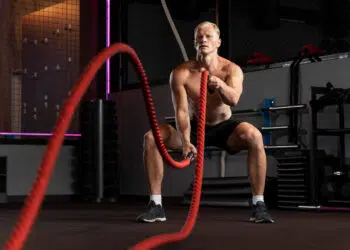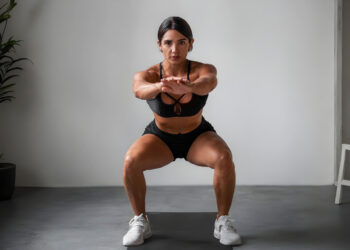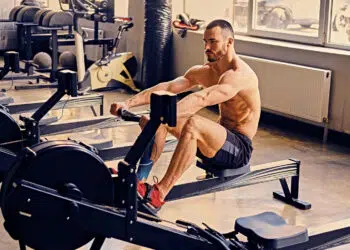Whatever your fitness goal is, metabolic conditioning (metcon) training will help you get there sooner. Metcon develops fitness, increases muscular endurance, improves your recovery ability, and can help you lose weight and get leaner, too.
There are several different ways to incorporate metcon into your workout routine, including circuit training and HIIT. However, it’s also helpful to have a library of metcon exercises to call on so that your workouts are never boring.
In this guide, we take a look at fast feet, explaining why and how to do this exercise, and reveal some of the best fast feet variations and alternatives.
Fast Feet – Muscles Worked
Fast feet is a cardio exercise and, as such, uses lots of different muscle groups. None of these muscles are particularly overloaded, so doing fast feet won’t lead to notable increases in size or strength. However, supplying the muscles involved in fast feet with oxygenated blood will increase your heart and breathing rate, which is the primary purpose of this exercise.
The main muscles involved in fast feet are:
Gastrocnemius and soleus – these two muscles make up your calves. During fast feet, you push strongly off your toes, which engages these muscles. Gastrocnemius plantar flexes your ankle and bends your knee, while the soleus is only a plantar flexor. Collectively, gastrocnemius and soleus are often called triceps surae.
Level Up Your Fitness: Join our 💪 strong community in Fitness Volt Newsletter. Get daily inspiration, expert-backed workouts, nutrition tips, the latest in strength sports, and the support you need to reach your goals. Subscribe for free!
Quadriceps – located on the front of your thighs, the quadriceps are made up of four muscles; rectus femoris, vastus lateralis, vastus medialis, and vastus intermedius. Known as the quads for short, these muscles work together to extend your knee joints while the rectus femoris also flexes your hip.
Hamstrings – opposing your quadriceps, the hamstrings flex your knees and extend your hips. The three hamstring muscles are the biceps femoris, semimembranosus, and semitendinosus.
Gluteus maximus – the glutes are the largest muscle in the human body. Located on the back of your hip, it’s your primary hip extender.
Abductors – located on the outside of your hips and thighs, the abductors are gluteus minimus, gluteus medius, and tensor fascia latae, or TFL for short. The abductors mainly act as stabilizers during fast feet and stop your knees from falling inward. Their primary function is the abduction of your hip. This means drawing your leg out and away from the midline of your body.
Adductors – consisting of adductors magnus, longus, and brevis, these muscles are located on the inside of your thighs. Like the abductors, during fast feet, they mainly act as stabilizers and stop your knees from falling outward. Their primary function is adduction of your hip, which means drawing your leg in toward the midline of your body.
How to Do Fast Feet
Get more from fast feet while keeping your risk of injury to a minimum by following these guidelines:
- Adopt an athletic stance with your knees slightly bent and feet about shoulder-width apart. Lean forward slightly from your hips.
- Rise up onto your toes and then run in place as fast as you can. Keep your hips low and your feet relatively close to the ground so you can move them as quickly as possible.
- Pump your arms in time with your feet, keeping your movements relatively small.
- Continue for the prescribed duration, e.g., 30 seconds, or number of repetitions, e.g., 50.
Fast Feet Benefits and Drawbacks
Not sure whether fast feet are worth adding to your metcon workouts? Check out these benefits:
No equipment required – cardio exercises don’t come much more convenient than fast feet. They require no equipment and very little space, so you can do them almost anywhere and anytime. They are the perfect excuse-free metcon exercise.
Good for speed and agility – as well as being a good cardio/metcon exercise, doing fast feet could increase your speed and agility. That’s why you’ll often see athletes doing this exercise. If you play sports, especially those involving sprinting or rapid direction changes, doing fast feet may improve your performance.
Easy to learn – if you can jog on the spot, you can probably do fast feet. Compared to things like burpees and box jumps, fast feet are pretty simple. If you are new to this exercise, start off at a comfortable pace, and speed up as you get used to it. It’s a self-regulating exercise that is suitable for beginner, intermediate, and advanced exercisers.
While fast feet are a mostly beneficial exercise, there are also a few drawbacks to consider:
Calf injuries – fast feet involved a rapid loading and unloading of your calf muscles (gastrocnemius and soleus). If you are unused to things like jumping and sprinting, and even if you train your calves regularly, this could result in calf muscle or Achilles tendon injuries. Minimize your risk of injury by introducing this exercise gradually into your workouts.
Limited overload – as you get fitter, you may find that this exercise is no longer hard enough to develop your fitness further.
Level Up Your Fitness: Join our 💪 strong community in Fitness Volt Newsletter. Get daily inspiration, expert-backed workouts, nutrition tips, the latest in strength sports, and the support you need to reach your goals. Subscribe for free!
You could try doing this exercise while wearing a weighted vest, and there is some evidence to suggest this may help improve agility and power (1). However this would also increase impact, and may not be a good solution for all exercisers.
The good news is that there are several more demanding exercises you can do instead of fast feet, which we’ve outlined in the next section.
Related: 10 Best Weighted Vests To Up Your Training Intensity
7 Fast Feet Variations and Alternatives
Fast feet is a highly effective metcon exercise, but that doesn’t mean you need to do it all the time. There are several variations and alternatives you can use to keep your workouts productive and interesting:
1. March or jog in place
The aim of fast feet is to pump your legs and arms as quickly as you can. However, if that’s a bit too tough for you at the moment, try marching in place instead. Just walk on the spot, lifting your knees and swinging your arms. Keep your torso upright – don’t lean back!
Once you’re are comfortable marching in place, try jogging on the spot instead. This increases foot speed and impact, preparing your muscles for fast feet.
2. In and outs
In and outs are a variation of fast feet. They involve more coordination and agility and also increase abductor and adductor engagement. Start slow and increase your speed as you get used to the additional movement.
How to do it:
- Adopt an athletic stance with your knees slightly bent and feet about shoulder-width apart. Lean forward slightly from your hips.
- Run in place as fast as you can, pumping your arms in time with your legs.
- As you run, bring your feet together for two steps, and then take your feet apart for two steps.
- Continue alternating ins and outs for the duration of your set.
3. Speed step-ups
Speed step-ups increase the agility demand of fast feet. They also involve some travel and a change of height. This makes them a little more demanding in terms of coordination. Use a low step so you can maintain a rapid foot speed. A higher step will force you to slow down, somewhat defeating the aim of the exercise.
How to do it:
- Stand facing a low step, e.g., 4 to 6-inches. Start doing fast feet, remembering to pump your arms.
- Maintaining your foot speed, step up and off your platform. Lead with the same leg for all your reps.
- Rest a moment, and then do your next set leading with the opposite leg.
- You can also do this exercise astride your box.
4. Jump rope
If you can jump rope, try combining it with fast feet. See how many jumps you can do in 30 or 60 seconds, pumping your legs as fast as you can in the process. Trying to turn a jump rope quickly increases upper body muscle engagement and will improve your agility and coordination.
However, even if you are an experienced rope jumper and fast footer, you probably won’t come close to the world record of 228 jumps in 30 seconds, currently held by this Chinese teenager!
Learn more about jumping rope in our in-depth guide.
5. Jumping jacks
Jumping jacks are another convenient, equipment-free metcon exercise. They involve a little more upper body movement, and you do them more slowly. But, like fast feet, they’re an effective exercise that you can do anywhere and anytime.
How to do it:
- Stand with your feet together and your hands by your sides.
- Jump your feet out to a little wider than shoulder-width apart while simultaneously lifting your arms out and arms above your head.
- Jump your feet back in and lower your arms.
- That’s one rep; keep going!
- If raising your arms above your head is too challenging, or causes shoulder pain, just lift your arms until they are parallel to the floor.
6. Fast mountain climbers
When most people do mountain climbers, they do them slowly to maximize core recruitment. However, you can also do mountain climbers using a faster leg action, making them more of a metcon exercise. If you have mastered regular mountain climbers and want an alternative to fast feet, give this one a try.
How to do it:
- Adopt the push-up position with your core braced and arms straight.
- Bend one leg and pull your knee into your chest.
- Drive that leg back while simultaneously pulling your opposite knee in.
- Keep quickly pumping your legs for the duration of your set.
7. Ali shuffles
Mohamed Ali was arguably the best heavyweight boxer ever. He’s definitely one of the most popular and well-known. Ali was known for his incredible footwork and ability to “float like a butterfly and sting like a bee.” The Ali shuffle exercise does not really replicate Ali’s fantastic footwork, but it will improve your footspeed and agility. This is a valuable alternative to standard fast feet.
How to do it:
- Place something like a broomstick or empty barbell on the floor sideways in front of you.
- Adopt a split stance with one foot in front of your stick/bar and one behind. Bend your knees slightly and adopt an athletic stance.
- Making a low jump, bring your rear leg forward and your front leg back, so you land with your feet reversed. Pump your arms in time with your legs.
- Immediately jump again and repeat.
- Stay low to the ground and focus on moving your feet as fast as possible.
Fast Feet – Wrapping Up
Fast feet is a simple yet effective conditioning, speed, and agility exercise. It’s a good move for adding to circuit and HIIT workouts. It involves no equipment, so you can do fast feet anywhere and anytime. Because you determine how fast you go, fast feet is suitable for beginner, intermediate, and advanced exercisers. Make it easier by going slower and harder by going faster; simple, and the epitome of self-regulation!
While doing fast feet won’t build bigger, stronger muscles, it’s a good exercise for improving cardiovascular fitness, coordination, and speed.
References:
1- PubMed: Effect of weighted vest suit worn during daily activities on running speed, jumping power, and agility in young men https://pubmed.ncbi.nlm.nih.gov/22266642/
Interested in measuring your progress? Check out our strength standards for Mountain Climbers, Jumping Jack, Burpees.








